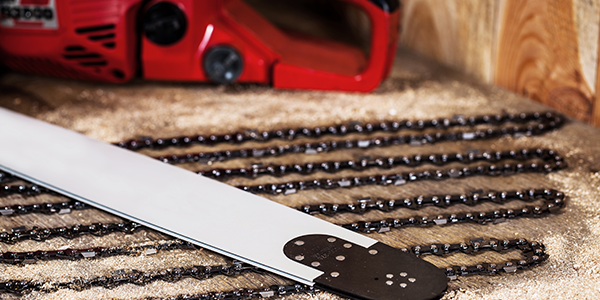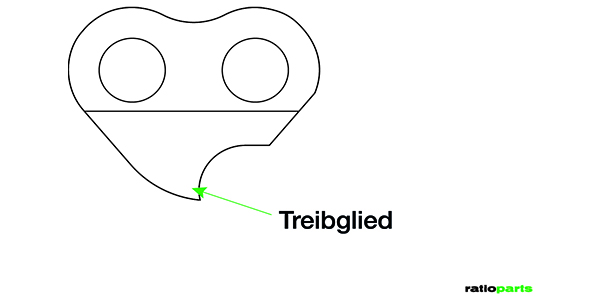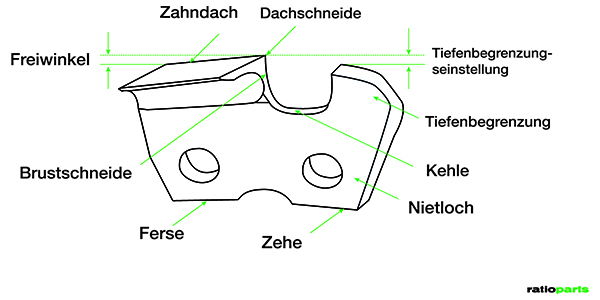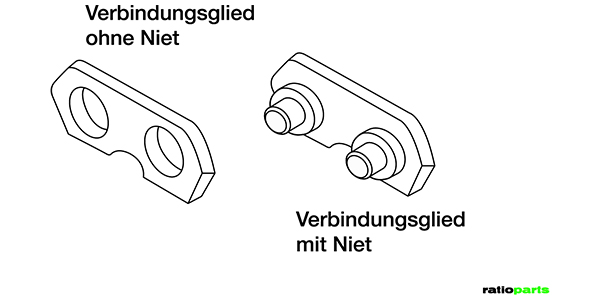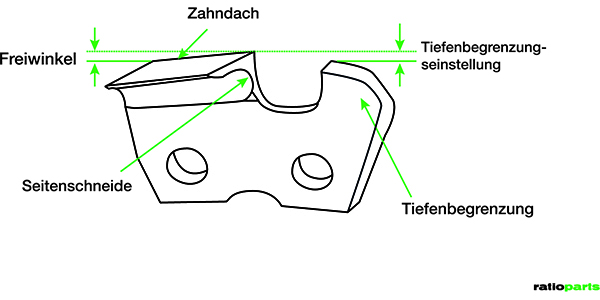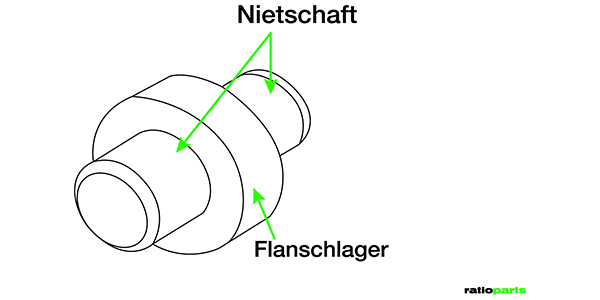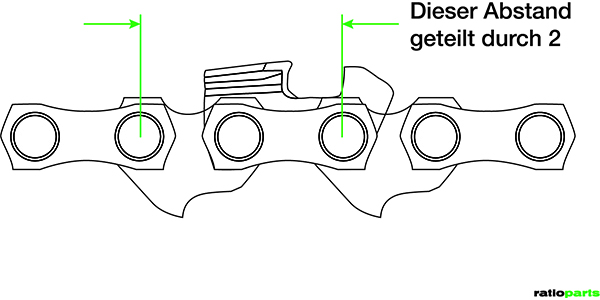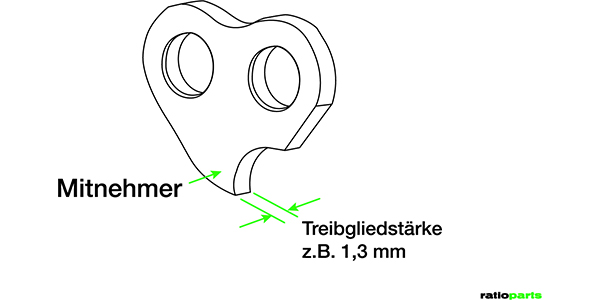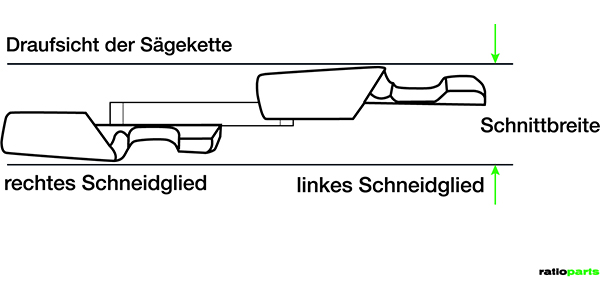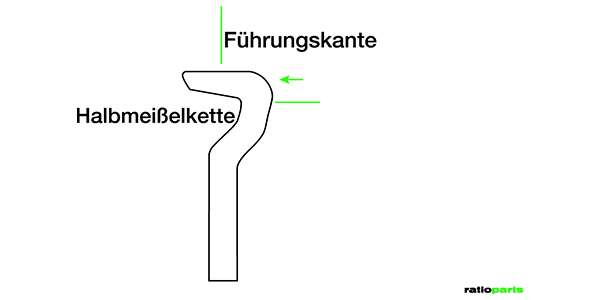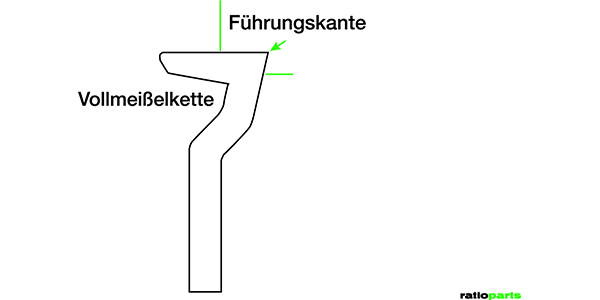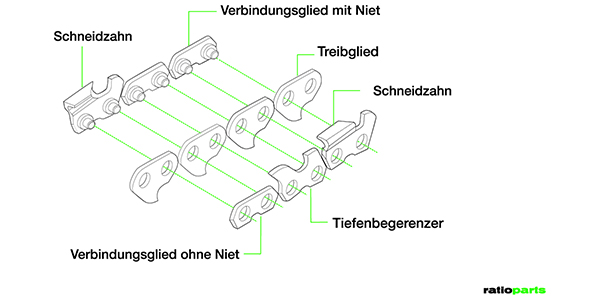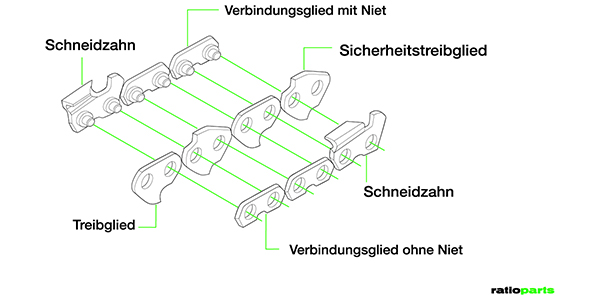There are several factors to consider when choosing the right saw chain for your chainsaw. Since this is not always easy due to the variety of chains for gasoline and electric chainsaws, we would like to explain the structure and the differences between saw chains so that you can gain a step-by-step insight and determine the right saw chain for your chainsaw.
On this page you will find information on the following topics:
>> How is a saw chain constructed
>> How do the variants of the cutting teeth on saw chains differ
>> What is the difference between saw chains with and without a safety drive link
How is a saw chain constructed and what are the components of a chain?
What is the chain pitch and how can I determine it?
The chain pitch indicates the actual size of the chain. The larger the chain pitch (measured in thousandths of an inch), the larger the saw chain. To determine the chain pitch, the distance between the centres of one and the next rivet is measured and the result is halved.
For a saw chain with a chain pitch of 3/8 "(0.375") this distance is 3/4 "(0.750").
What does drive link thickness mean?
The chain width (drive link thickness) corresponds to the strength of the drive links guided in the blade groove (recess in the guide rail also called blade) and is also measured in thousandths of an inch. Saw chains for hand chain saws are offered in four standard widths:
The chain pitch of the saw chain must match the pitch of the drive pinion and, if necessary, the pinion nose of the blade (guide bar). The width of the saw chain must match the width of the blade. Using of chainsaw parts that do not match will lead to the premature failure of the saw chain, blade or drive pinion.
What do you mean when you talk about cutting width?
The cutting width is the width of the cutting kerf that the saw chain creates in the wood. The cutting width is measured from the outside edge of the left to the outside edge of the right cutting link.
What is the difference between saw chains with half-chisels or full chisels?
The size, shape and leading edge of the cutting teeth determine the performance and durability of the saw chain. The half-chisel chain has a tapered tooth roof and a bevelled side cutting edge, as well as a leading edge with a smaller radius. This leads to a significantly higher cutting performance without a significant reduction in durability. The full chisel chain with an acute-angled leading edge is designed for maximum cutting performance. The flat cutting edge of the full chisel chain cuts considerably faster because it cuts through all wood fibres over the entire cutting width in one line. Here, the actual leading edge of the tip does most of the cutting work and is therefore easily damaged under harsh operating conditions.
For this reason, the full chisel chain is best suited for clean, standing wood. You can achieve optimum cutting performance with a saw chain that is suitable for the respective working conditions. The full chisel chain is used very often and is suitable for tough working conditions. It is designed for professional use since the leading edge tip is more easily damaged if used improperly. The half-chisel chain is the best compromise between speed and durability.
What is the difference between a saw chain with a safety drive and a saw chain without?
How does a saw chain cut?
What is the depth gauge on saw chains?
What does kickback mean when working with a chainsaw?
Here are some safety precautions that can help you to work safely with the chainsaw ...
| >> | Always hold the chainsaw from the right-handed grip: the right hand on the throttle lever and the left hand on the front handle. NEVER work with one hand! |
| >> | Keep your left arm straight for better control. |
| >> | Hold the chainsaw firmly in both hands. Grasp the front handle with your thumb. |
| >> | Stand next to the chainsaw, never behind it. |
| >> | Run the engine at full throttle. |
| >> | If possible, always use a saw chain and a blade with a low tendency to kickback. |
| >> | Regularly maintain the chainsaw, saw chain, blade and drive pinion. |
| >> | Make sure you have a firm footing and keep your balance. |
| >> | Only use the chainsaw for cutting wood. Do not cut other materials. |
| >> | Keep the escape route free to protect against falling trunks and branches. |
| >> | Carefully inspect the work area. Before cutting, check the area for possible hazards such as branches, power lines, dead trees, etc. Calculate the direction in which the clippings will fall. Determine if the movement of the clippings can cause the chainsaw to suddenly jump. If possible, stand in a safe place away from the natural slope of the tree to avoid injury. |
| >> | Never cut above shoulder height. |
| >> | Never cut while standing in a tree or on a ladder. |
| >> | Keep bystanders at least two tree lengths away from the work area. |
| >> | Do not allow other people to hold the wood while cutting. |
| >> | Do not use the chainsaw if you are tired or unwell. |
| >> | Attach the appropriate blade guard to transport the chainsaw. |

 Deutsch
Deutsch
 English
English
 Suomi
Suomi
 France
France
 Ungarisch
Ungarisch
 Niederländisch
Niederländisch
 Italienisch
Italienisch

